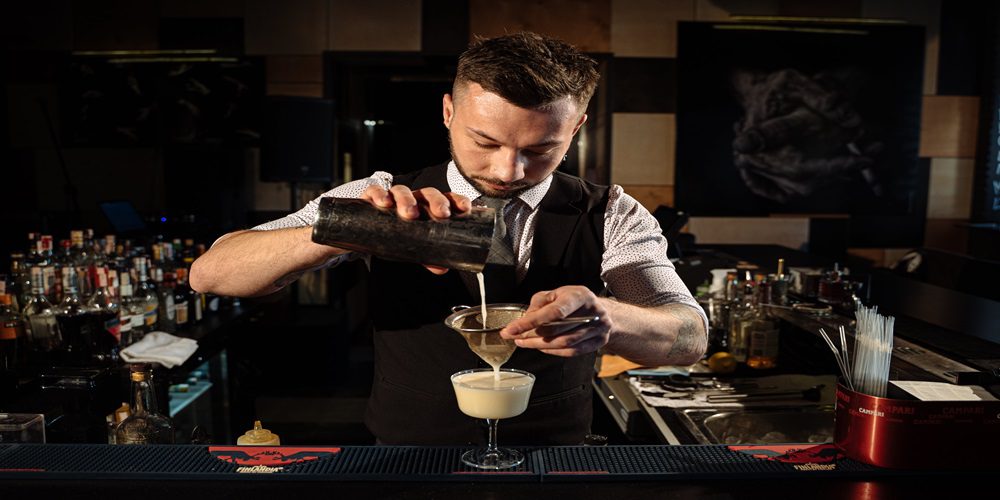Welcome to the world of mixology – where science meets art, and deliciousness is crafted sip by sip. Whether you’re a seasoned cocktail connoisseur or simply someone who appreciates a well-crafted beverage, there’s no denying the allure and intrigue that surround the art of mixing drinks. In this blog post, we delve into the fascinating realm of mixology, exploring not only its scientific foundations but also the creative flair and mastery behind crafting tantalizing libations. So grab your shakers and garnishes as we uncover the secrets that make mixology both an exacting science and an awe-inspiring art form. Cheers!
Introduction to Mixology and its History
Mixology may seem like a trendy word in the world of cocktails, but it has actually been around for centuries. It is defined as the art and science of mixing drinks, and it involves combining different ingredients in a way that creates harmonious and delicious flavors. In this section, we will take a closer look at mixology and its rich history.
The birth of mixology can be traced back to ancient civilizations such as Egypt, Greece, and Rome. During these times, herbal remedies were often mixed with wine or other spirits for medicinal purposes. This is where the concept of combining liquids with different herbs, spices, and fruits first originated.
However, it was not until the 19th century when mixology truly flourished. With the invention of new distillation techniques and an increase in global trade routes, more varieties of spirits became available to people all over the world. This led to an explosion of creativity among bartenders who began experimenting with different flavor combinations to create unique drinks.
One notable event in mixology history was the publication of “The Bon Vivants Companion” by Jerry Thomas in 1862. This book is considered one of the earliest cocktail guides and contains numerous recipes for both classic and innovative cocktails.
During Prohibition in the United States from 1920-1933, mixology went underground as alcohol consumption became illegal. However, this did not stop people from indulging in their favorite cocktails. Speakeasies emerged during this time as secret bars where people could enjoy illicit drinks crafted by skilled mixologists.
In the mid-20th century, mixology reached new heights with iconic cocktails such as the Martini, Bloody Mary, Old Fashioned, and Manhattan gaining popularity. These drinks have stood the test of time and are still enjoyed by many today.
In recent years, there has been a resurgence in interest towards craft cocktails and quality ingredients among both bartenders and consumers. This has led to the rise of mixology as an art form, with competitions, schools, and books dedicated to perfecting the craft.
The Science behind Flavor Combinations
Flavor combinations are an essential aspect of mixology. They can make or break a beverage, and mastering the science behind them is crucial for creating delicious and well-balanced drinks. In this section, we will explore the chemistry and psychology behind flavor combinations to understand why certain flavors work well together.
The first key factor in flavor combinations is molecular compatibility. Each ingredient in a beverage has unique molecules that interact with each other in different ways. Some molecules complement each other, while others clash. For example, citrus fruits like lemons and limes have high levels of citric acid, which pairs well with the sweetness of sugar or honey. On the other hand, dairy products have molecules that bind to tannins found in wine, making them a poor combination.
Another important aspect is mouthfeel –the physical sensation experienced when consuming food or drinks. The texture and consistency of ingredients can greatly impact how they are perceived by our taste buds. When crafting a drink, it’s essential to consider how various ingredients will feel when mixed together. For instance, carbonated drinks add a bubbly sensation that enhances certain flavors but may not pair well with creamy textures.
While molecular compatibility plays a significant role in flavor combinations, it’s also vital to understand the psychological aspects of taste perception. Our brains are constantly making associations between flavors we’ve previously tasted and smells we’ve encountered before; these experiences influence our preferences for certain foods and beverages.
One area where psychology comes into play is with cultural tastes and flavor pairings passed down through generations within specific cultures or regions. For example, many Asian cuisines incorporate spicy elements like chili peppers into their dishes as key ingredients due to cultural preferences developed over time.
Another fascinating aspect is individual differences in taste perception based on genetics; individuals’ sensitivity to bitter compounds varies greatly due to genetic makeup. It explains why some people may enjoy black coffee while others find it too bitter without any additives like creamer or sugar. These individual differences in taste perception highlight the importance of experimentation and customization when crafting beverages, as what may work for one person may not be suitable for another.
Types of Alcoholic and Non-Alcoholic Beverages
There is an endless variety of beverages available today, both alcoholic and non-alcoholic. From classic cocktails to modern mocktails, the options seem to be ever-expanding. But what exactly are the different types of beverages? Let’s explore some popular categories and their characteristics.
Alcoholic Beverages:
1. Spirits – These are distilled alcoholic beverages made from a fermented product such as grain, fruits or vegetables. Vodka, gin, whiskey, rum and tequila are all examples of spirits.
2. Wine – The process of making wine involves fermenting grapes or other fruits using yeast. There are various types of wine depending on the type of grapes used, fermentation process and aging techniques.
3. Beer – This is a fermented beverage made from malted barley, hops, water and yeast. Different types of beer can be created by changing the proportions or ingredients used during brewing.
4. Liqueurs – These are sweetened spirits that have been flavored with herbs, spices or fruits. Examples include amaretto, triple sec and schnapps.
Non-Alcoholic Beverages:
1.Mixers- As the name suggests these are drinks that complement an alcoholic beverage when mixed together in cocktails. One great example could be tonic water which pairs well with gin for a refreshing Gin & Tonic cocktail.
2.Juices- Freshly extracted juices from fruits like orange, pineapple, tomato etc provide vitamins, minerals, and goodness without alcohol incorporated. One can mix these juices into smoothies, detox cleanse drinks, cold pressed shots according to one’s taste preference.
3.Sodas- Carbonated soft drinks like Coke, Pepsi, soda water offer sweetness & fizz without any trace amount of alcohol. These can also act as mixers for many cocktails owing to its carbonation property which helps in creating balanced fizzy drink concoctions.
4.Mocktails- Popularly known as the non-alcoholic version of cocktails, mocktails are made by using various ingredients such as fresh fruit juices, herbs, syrups and sodas. They offer a refreshing alternative for those looking to enjoy flavorful beverages without alcohol.
5.Herbal Infusions- These include drinks like herbal teas and tisanes which are created by steeping herbs, spices or flowers in hot water. They can be enjoyed both hot or cold and provide various health benefits depending on the ingredients used.
Essential Tools for Crafting Delicious Drinks
Crafting delicious drinks is a skill and art that requires precision, experimentation, and the right tools. While the ingredients are crucial in creating a flavorful beverage, having the essential tools can elevate your mixology game to the next level. In this section, we will discuss some of the must-have tools for crafting delicious drinks.
1. Cocktail Shaker:
A cocktail shaker is one of the most essential tools in mixology. It plays a crucial role in blending and mixing ingredients together to create a perfectly balanced drink. Shakers come in various sizes and designs, but a Boston shaker (a two-piece set consisting of a metal tumbler and glass) is ideal for both beginners and professionals alike.
2. Jigger:
A jigger is a small measuring tool used to measure precise amounts of liquid, usually 1-2 ounces. This tool is essential in mixology as it ensures accuracy when adding ingredients into your cocktail shaker or glass.
3. Bar Spoon:
A bar spoon is longer than regular spoons with its handle ending in a disk or spiral design at one end. This tool comes in handy when stirring cocktails to evenly distribute flavors without diluting the drink.
4. Muddler:
For those who love muddled fruit or herbs in their cocktails, getting yourself a muddler should be on top of your list. A muddler helps release the juices and oils from fruits and herbs, enhancing the flavor profile of your drink.
5. Strainer:
A strainer prevents pulp, ice cubes, or herbs from falling into your glass when pouring out cocktails from the shaker. There are several types of strainers available such as Hawthorne strainers used for shaking cocktails with ice cubes or Julep strainers commonly used for stirred drinks served over ice.
6.Liquid Pourer:
Liquid pourers are useful tools that help control how much liquor you add into your drink during the pouring process. They also help prevent spills, making them a convenient and practical tool for mixologists.
7. Citrus Juicer:
Freshly squeezed citrus juice can make or break a cocktail. Having a manual citrus juicer allows you to extract as much juice as possible from fruits like lemons, limes, and oranges, ensuring the perfect balance of flavors in your drink.
8. Ice Tools:
Having the right ice is crucial in mixology as it can affect the taste, dilution rate, and overall presentation of your drink. Tools like ice molds, ice tongs, and an ice crusher can go a long way in providing different textures and temperatures for your cocktails.
Tips and Tricks from Expert Mixologists
Mixology is both a science and an art, and mastering the craft takes time, patience, and plenty of practice. Luckily, we have some expert mixologists to help us along the way by sharing their tried and true tips and tricks. These experienced professionals have spent years honing their skills and perfecting their techniques, so who better to learn from?
1. Start with Quality Ingredients
The first tip from our expert mixologists is to always start with quality ingredients. From spirits to juices to garnishes, each ingredient plays an important role in creating a delicious cocktail. Choose fresh produce for muddling or garnishing, opt for premium spirits over low-quality ones, and pick organic juices when possible.
2. Measure Accurately
To ensure consistency in your cocktails, it’s crucial to measure your ingredients accurately. This means using a jigger or measuring tool instead of eyeballing it or relying on free-pouring techniques. Some mixologists even recommend weighing ingredients rather than measuring them by volume for more precise results.
3. Use Fresh Citrus
Fresh citrus juice can make all the difference in a cocktail’s flavor profile compared to store-bought bottled options. Our experts suggest squeezing lemons or limes right before mixing instead of using pre-made bottled juices that may contain preservatives or added sugars.
4. Experiment with Flavor Combinations
While there are classic recipes that never go out of style, don’t be afraid to mix things up by trying new flavor combinations. Our mixologists recommend experimenting with different types of bitters, syrups, herbs, spices, and other unique ingredients to create your own signature cocktails.
5. Pay Attention to Dilution
Dilution can significantly affect the taste and texture of a cocktail – too much dilution can make a drink watery while too little can result in an overpowering taste of alcohol. Our experts advise experimenting with different ice-to-liquid ratios until you find the right balance for your desired drink.
6. Know Your Glassware
Different cocktails are traditionally served in specific types of glassware, and for a good reason. For example, a martini is typically served in a stemmed glass with a V-shaped bowl to prevent heat from the hands warming up the drink. Knowing which glassware to use not only enhances the presentation of your cocktail but also affects its taste and aroma.
7. Garnish with Purpose
Garnishes aren’t just decorative; they serve a purpose in elevating the flavor of a cocktail. Our mixologists suggest using garnishes that complement or enhance the flavors of your chosen ingredients – whether it’s adding citrus zest for brightness or a sprig of herbs for an aromatic touch.
8. Practice Good Technique
Our experts emphasize good technique as crucial to creating top-notch cocktails. This includes mastering basic methods like shaking, stirring, muddling, and straining, as well as more advanced techniques like dry-shaking for frothy drinks or using biodegradable straws for eco-friendly serving options
Pairing Cocktails with Food: Creating a Perfect Harmony
Pairing cocktails with food is an aspect of mixology that is often overlooked but can greatly enhance your dining experience. Just like how certain types of wine complement specific dishes, different cocktails can also bring out the flavors in various foods. This perfect harmony between cocktails and food is achieved through a careful consideration of flavor profiles, textures, and ingredients.
Firstly, it’s important to understand the flavor profile of both the cocktail and the dish you are pairing it with. The primary tastes – sweet, salty, sour, bitter, and umami – should be balanced between the two. For example, if your dish is on the sweeter side, then a cocktail with a hint of bitterness would be an ideal match to balance out those flavors. Similarly, a savory cocktail with umami notes would pair well with a rich and flavorful meal.
Texture is another crucial factor to consider when pairing cocktails with food. A light and refreshing cocktail works well with lighter dishes such as salads or seafood. On the other hand, a more robust cocktail with creamy or frothy textures complements heartier dishes like steak or pasta.
Another aspect to keep in mind when creating harmonious pairings is considering the ingredients used in both the cocktail and dish. It’s best to use similar flavor components in both to create complementary flavors rather than contrasting ones. For instance, citrus-based cocktails work well with seafood due to their shared acidic flavors.
Additionally, regional cuisine can provide inspiration for pairing cocktails and food together. Matcha-infused drinks pair beautifully with Japanese cuisine while tequila-based drinks go hand in hand with Mexican dishes.
The seasonality of ingredients should also be taken into account when crafting these combinations. Summer-inspired cocktails bursting with fresh fruits marry perfectly with light summer meals like grilled fish or vegetable skewers while winter spices like cinnamon add warmth to dessert-style cocktails paired with hearty meals such as roasted meats.
Creative Garnishes and Presentation Techniques
Creativity and presentation are essential elements of mixology. Not only do they make the drink visually appealing, but they also enhance the overall experience for the consumer. The use of creative garnishes and presentation techniques can elevate a simple cocktail into a work of art.
One way to add creativity to drinks is with unique garnishes. These can range from fresh fruits and herbs to edible flowers and flavored sugar rims. Bright citrus slices or curls, such as lemon or orange, not only add a pop of color but also provide a burst of flavor when placed on top or inside the drink. Fresh herbs, like rosemary sprigs or mint leaves, offer an aromatic element that can enhance the taste and aroma of a cocktail.
Another popular trend in mixology is using edible flowers as garnishes. Not only do they add beauty to an already exquisite drink, but their delicate petals also provide subtle hints of floral notes that complement certain flavors in the beverage. Examples include candied violets on a lavender-infused martini or hibiscus blossoms on a tropical rum-based cocktail.
For those looking for something more unconventional, consider experimenting with flavored sugars or salts to rim glasses. This adds both visual interest and provides a unique taste experience for drinkers as they sip their cocktails through the sweetened or salted edge.
Presentation is another crucial aspect of crafting delicious beverages that cannot be overlooked. How you present your drink creates anticipation and sets expectations for what’s about to be consumed. From choosing the right glassware to using different serving vessels like mason jars or copper mugs, presentation options are endless.
Glassware plays an important role in how drinks are received by consumers. Different glasses have specific purposes based on ingredients used in cocktails – stemless wine glasses are ideal for mixed drinks served without ice while short rocks glasses are perfect for whiskey-based cocktails served over ice cubes. Using unexpected glassware like martini glasses for serving non-alcoholic spritzers can add a fun twist to your drink’s presentation.
In addition to glassware, mixologists are also using unique serving vessels such as hollowed-out fruits, like watermelons or pineapples, for tropical drinks or test tubes and beakers for science-inspired cocktails. These unconventional vessels not only add a quirky touch but also create an interactive element that engages the senses of the consumer.
Unique and Trendy Beverage Recipes to Try at Home
In the world of mixology, there is an endless array of beverage recipes to explore and experiment with. While classic cocktails like the Old Fashioned and Martini will never go out of style, trying out unique and trendy beverage recipes can add a fun twist to your at-home mixology game.
Here are some delicious and innovative beverage recipes that will impress your guests and elevate your cocktail repertoire:
1. Matcha Mojito: This refreshing twist on a traditional mojito combines the earthy flavors of matcha tea with the zing of fresh lime and mint. To make this drink, muddle fresh mint leaves with sugar in a glass. Add ice, 1 shot of white rum, 1/2 tsp matcha powder, and the juice of one lime. Top it off with club soda for a bubbly finish.
2. Lavender Gin Fizz: Step up your gin game with this floral spin on the classic gin fizz cocktail. In a shaker filled with ice, combine 1 shot of gin, 1 tbsp lavender syrup (can be made by simmering dried lavender in equal parts water and sugar), 1 egg white, and 1/4 cup lemon juice. Shake well until frothy and strain into a highball glass filled with ice. Top it off with some soda water for added effervescence.
3. Spicy Watermelon Margarita: Bring some heat to your margarita game by infusing it with juicy watermelon chunks and spicy jalapeno peppers. Start by muddling together chunks of seedless watermelon, jalapeno slices (without seeds), and agave nectar in a cocktail shaker. Then add ice, 2 shots of tequila, 1 shot triple sec or Cointreau, and the juice of one lime to the mixture before shaking vigorously. Strain into a salt-rimmed glass filled with ice and garnish with a watermelon wedge.
4. Strawberry Basil Vodka Lemonade: This sweet and herbaceous cocktail is perfect for a warm summer evening. In a glass, muddle together fresh strawberries and basil leaves with sugar. For the lemonade base, mix together 1 shot of vodka, 1/2 cup lemon juice, and 1 tbsp honey in a shaker with ice. Shake well and pour over the muddled strawberry mixture. Top it off with club soda for some fizz.
5. Charcoal Whisky Sour: This unconventional take on the classic whisky sour is not only visually striking but also full of surprising flavors. In a shaker filled with ice, combine 2 shots of whisky (preferably bourbon), 3/4 shot fresh lemon juice, 1/2 shot simple syrup, and 1 tsp activated charcoal powder (available at health stores). Shake vigorously and strain into a rocks glass filled with ice. Garnish with an orange peel or cherry.
Alternatives for Alcohol-Free Mixing: Mocktails, Shrubs, and Infusions
When it comes to mixing beverages, alcohol is often a key ingredient for creating complex and flavorful drinks. However, not everyone enjoys or can consume alcohol, whether due to personal preference or health reasons. Thankfully, there are plenty of alternatives for alcohol-free mixing that are just as refreshing and delicious. In this section, we will explore three popular options: mocktails, shrubs, and infusions.
Mocktails are non-alcoholic cocktails that mimic the taste and presentation of traditional alcoholic drinks. They have gained popularity in recent years as more people opt for healthier lifestyles without sacrificing socializing or going out. Mocktails use a combination of fruit juices, flavored syrups, bitters, herbs, and spices to create unique flavor profiles. Some common ingredients used in mocktails include cranberry juice, lemon-lime soda, grenadine syrup, and mint leaves. With the right ingredients and techniques, a mocktail can be just as sophisticated and satisfying as its alcoholic counterpart.
Shrubs have been around since colonial times but have recently made a comeback in the mixology scene. Made from a mixture of vinegar-based syrup (usually apple cider vinegar) with fruits or herbs steeped in it for several days to weeks – shrubs add a tangy kick to mixed drinks without any added alcohol content. The sweet-tart balance from shrubs provides an earthy depth to cocktails when coupled with soda water or used as an accent flavoring agent.
Infusions involve soaking various fruits or botanicals in a base liquid such as water or simple syrup over time until all flavors meld together completely resulting in a uniquely flavored cocktail ingredient called “infusion.” Using infusions provides ample opportunities for experimentation and customization of flavors driven by seasonality-inspired themes like strawberry-basil-cucumber infused gin.
These non-alcoholic mixes offer limitless possibilities which lend themselves extremely well towards adapting classic drink recipes – something invariably done successfully with infused spirits tastes too! The internet is full of interesting infusions’ techniques, recommendations on how to get them ideal in the region-specific liquors for sale only there. These options are excellent avenues to show off your skills and impress guests with alcohol-free but still flavorful beverages.
Conclusion
Mixology is a fascinating blend of science and art, combining chemistry, psychology, and creativity to craft delicious beverages. With the use of unique ingredients, innovative techniques, and a deep understanding of flavor profiles, mixologists are able to create drinks that not only taste great but also evoke emotions and experiences. As we continue to explore new flavors and push boundaries in mixology, one thing remains constant: the joy and satisfaction that comes from crafting the perfect drink for someone’s enjoyment. So shake up your own creative juices and start crafting your own delicious beverages today!


































